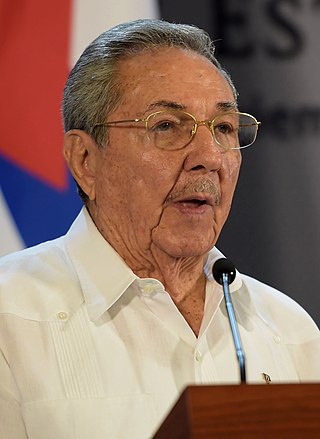
Raúl Modesto Castro Ruz is a Cuban retired politician and general who served as the first secretary of the Communist Party of Cuba, the most senior position in the one-party communist state, from 2011 to 2021, and President of Cuba between 2008 and 2018, succeeding his brother Fidel Castro.

The Cuban Revolution was the military and political overthrow of Fulgencio Batista's dictatorship, which had reigned as the government of Cuba between 1952 and 1959. The revolution began after the 1952 Cuban coup d'état, which saw Batista topple the nascent Cuban democracy and consolidate power. Among those opposing the coup was Fidel Castro, then a novice attorney who attempted to contest the coup through Cuba's judiciary. Once these efforts proved fruitless, Fidel Castro and his brother Raúl led an armed attack on the Cuban military's Moncada Barracks on 26 July 1953.
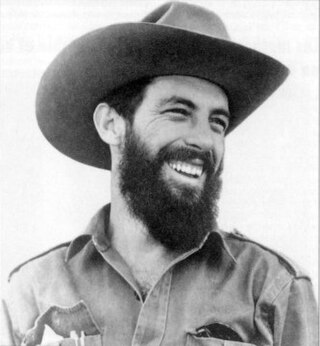
Camilo Cienfuegos Gorriarán was a Cuban revolutionary. One of the major figures of the Cuban Revolution, he was considered second only to Fidel Castro among the revolutionary leadership.
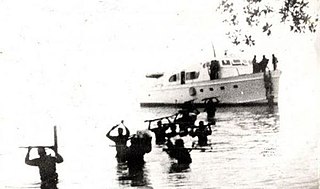
Granma is a yacht that was used to transport 82 fighters of the Cuban Revolution from Mexico to Cuba in November 1956 to overthrow the regime of Fulgencio Batista. The 60-foot diesel-powered vessel was built in 1943 by Wheeler Shipbuilding of Brooklyn, New York, as a light armored target practice boat, US Navy C-1994, and modified postwar to accommodate 12 people. "Granma", in English, is an affectionate term for a grandmother; the yacht is said to have been named for the previous owner's grandmother.

The 26th of July Movement was a Cuban vanguard revolutionary organization and later a political party led by Fidel Castro. The movement's name commemorates the failed 1953 attack on the Moncada Barracks in Santiago de Cuba, part of an attempt to overthrow the dictator Fulgencio Batista.
Arnaldo Tomás Ochoa Sánchez was a Cuban general who was executed by the government of Fidel Castro after being found guilty of a variety of crimes including drug smuggling and treason.

Huber Matos Benítez was a Cuban military leader, political dissident, activist, and writer. He opposed the dictatorship of Fulgencio Batista from its inception in 1952 and fought alongside Fidel Castro, Raúl Castro, Che Guevara, Camilo Cienfuegos and other members of the 26th of July Movement to overthrow it. Following the success of the Cuban Revolution that brought Fidel Castro to power, he criticized the regime's shift in favor of Marxist principles and ties to the Popular Socialist Party (PSP). Convicted of treason and sedition by the revolutionary government, he spent 20 years in prison (1959–1979) before being released in 1979. He then divided his time between Miami, Florida, and Costa Rica while continuing to protest the policies of the Cuban government.

Juan Almeida Bosque was a Cuban politician and one of the original commanders of the insurgent forces in the Cuban Revolution. After the rebels took power in 1959, he was a prominent figure in the Communist Party of Cuba. At the time of his death, he was a Vice-President of the Cuban Council of State and was its third ranking member. He received several decorations, and national and international awards, including the title of "Hero of the Republic of Cuba" and the Order of Máximo Gómez.
The Cuban Revolution was the overthrow of Fulgencio Batista's regime by the 26th of July Movement and the establishment of a new Cuban government led by Fidel Castro in 1959.

Cienfuegos, also known as Elefantes de Cienfuegos, was a Cuban baseball team that played in the old Cuban League, which existed from 1878 to 1961. Although representing the south coast city of Cienfuegos, the team played their home games in Havana.
Osmany Cienfuegos Gorriarán is a Cuban politician and older brother of Camilo Cienfuegos. He has served in various roles in the Cuban government.
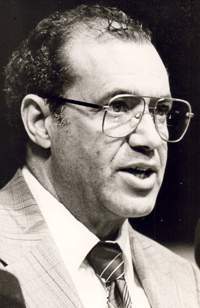
Sergio del Valle Jiménez was a high-ranking Cuban military and government official who served as army chief of staff during the 1962 Missile Crisis and headed various cabinet ministries during the 1960s, 1970s and 1980s.

Ramón M. Barquín was a Cuban military colonel and opponent of former President Fulgencio Batista. Barquín was jailed by the Batista government for leading a failed coup attempt in 1956. He later fled Cuba in 1960 following the 1959 takeover by Fidel Castro.

The Triumph of the Revolution is the historical term for the flight of Fulgencio Batista on January 1, 1959, and the capture of Havana by the 26th of July Movement on January 8.
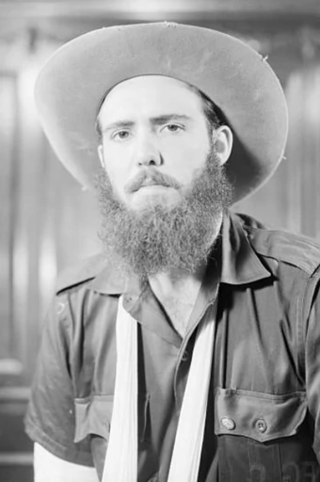
Rolando Cubela Secades was a Cuban revolutionary leader who played a vital part in the Cuban Revolution, having been a founding member of the Directorio Revolucionario Estudiantil and later the military leader of the DRE's Escambray Mountain front, achieving the rank of Commander, the highest military rank in the Revolutionary Army. After the Revolution succeeded in 1959, Cubela became Cuba's envoy to UNESCO. Under the cryptonym AM/LASH, Cubela became "an important asset" of the Central Intelligence Agency, and worked with them on plots to assassinate Fidel Castro. In 1966, Cubela was arrested for plotting the assassination of Castro, and sentenced to 25 years in prison. Released in 1979, he went into exile in Spain.
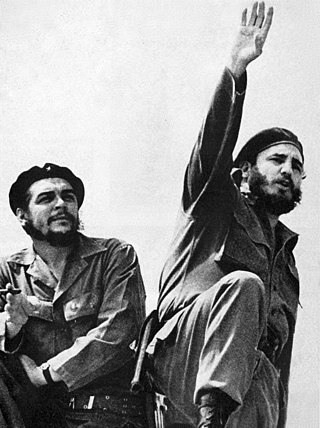
The consolidation of the Cuban Revolution is a period in Cuban history typically defined as starting in the aftermath of the revolution in 1959 and ending in 1962, after the total political consolidation of Fidel Castro as the maximum leader of Cuba. The period encompasses early domestic reforms, human rights violations, and the ousting of various political groups. This period of political consolidation climaxed with the resolution of the Cuban missile crisis in 1962, which then cooled much of the international contestation that arose alongside Castro's bolstering of power.
Manuel Piti Fajardo Rivero was a Cuban revolutionary physician and fighter of the Rebel Army in the Sierra Maestra.
The Camilo Cienfuegos Military Schools System are a type of boarding school in the Cuban Revolutionary Armed Forces. Founded 1966, it has 20 campuses in many cities, and is an official military high school. They provide pre-military training to students aged 11 to 17. They forge of more than 70% of officers and 50% of the generals and colonels in the FAR. It is named after Camilo Cienfuegos, a Cuban revolutionary who, along with Fidel Castro, Che Guevara, Juan Almeida Bosque, and Raúl Castro, took part in the 1956 Granma expedition. Unlike the Russian Suvorov Military Schools, they are co-educational, modeled on United States military high schools and preparatory pre-college institutes.

The Colegio de Belén is a private religious school in Marianao, Havana, located between 45th and 66th streets, next door to the Tropicana nightclub,. It was designed in 1925 by the architect Leonardo Morales y Pedroso and his brother the engineer Luis Morales y Pedroso of the firm Morales y Compañía Arquitectos.
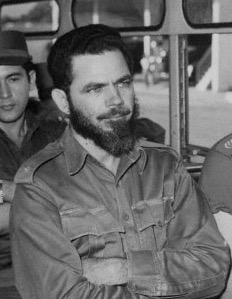
The Huber Matos affair was a political scandal in Cuba when on October 20, 1959, army commander Huber Matos resigned and accused Fidel Castro of "burying the revolution". Fifteen of Matos' officers resigned with him. Immediately after the resignation, Castro critiqued Matos and accused him of disloyalty, then sent Camilo Cienfuegos to arrest Matos and his accompanying officers. Matos and the officers were taken to Havana and imprisoned in La Cabaña. Cuban communists later claimed Matos was helping plan a counter-revolution organized by the American Central Intelligence Agency and other Castro opponents, an operation that became the Bay of Pigs Invasion.















